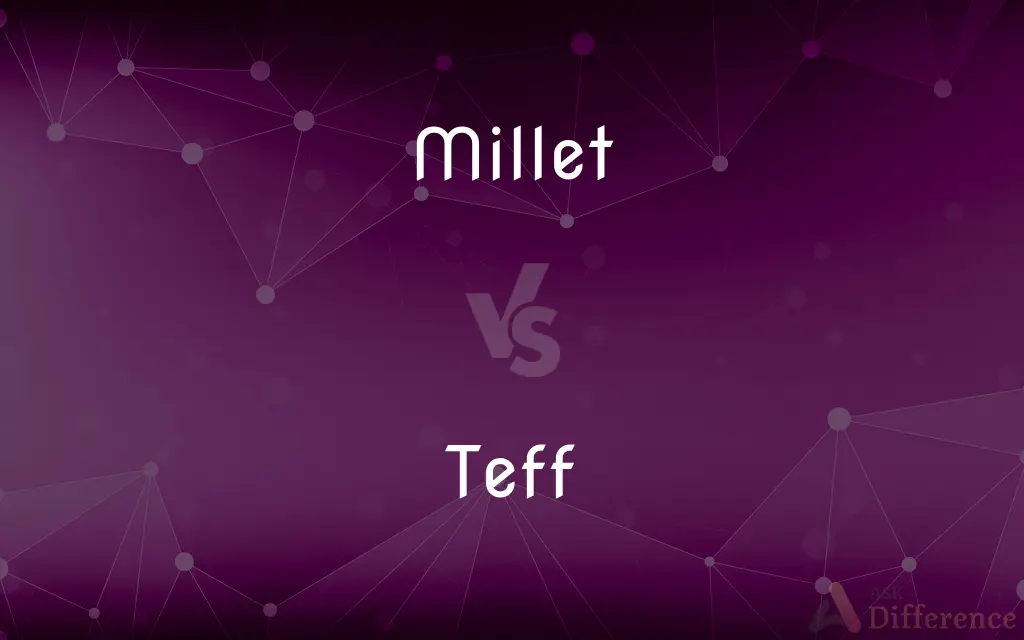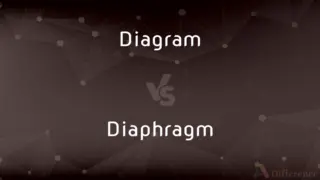Millet vs. Teff — What's the Difference?
By Urooj Arif & Fiza Rafique — Updated on April 24, 2024
Millet is a versatile, coarse-grained cereal grown widely, while teff is a fine-grained Ethiopian staple rich in calcium.

Difference Between Millet and Teff
Table of Contents
ADVERTISEMENT
Key Differences
Millet is known for its adaptability to harsh environments and poor soils, making it a staple in arid regions of Asia and Africa. Whereas, teff thrives best in environments with moderate rainfall, predominantly cultivated in the highlands of Ethiopia.
Millet grains are larger and can be cooked fluffy like rice or used in porridges. On the other hand, teff grains are much smaller, often ground into flour and used to make injera, a traditional Ethiopian flatbread.
Millet is rich in iron, B vitamins, and dietary fiber, supporting a healthy diet. Whereas, teff is exceptionally high in calcium and resistant starch, which is beneficial for blood sugar management.
Millet has a mild, slightly nutty flavor, making it a versatile ingredient in both savory and sweet dishes. On the other hand, teff has a slightly earthy taste, which complements the flavors of the fermented dishes it often accompanies.
Millet is available in several varieties like pearl, foxtail, and finger, each with distinct uses and nutritional profiles. Whereas, teff is primarily available in its natural form, though it can vary in color from ivory to dark brown.
ADVERTISEMENT
Comparison Chart
Grain Size
Coarser, larger grains
Fine, small grains
Ideal Growing Conditions
Tolerates dry, arid climates
Prefers moderate rainfall
Nutritional Content
High in iron, B vitamins, dietary fiber
High in calcium, resistant starch
Flavor Profile
Mild, nutty
Earthy
Varieties
Pearl, foxtail, finger
Typically only one main type
Compare with Definitions
Millet
A coarse, edible grain used in various dishes worldwide.
Millet porridge is a nutritious breakfast option.
Teff
Cultivated predominantly in Ethiopia and Eritrea.
Teff cultivation is integral to farming practices in the Ethiopian highlands.
Millet
Gluten-free cereal grain, suitable for various diets.
Gluten-sensitive individuals can substitute rice with millet.
Teff
Used to produce gluten-free products.
Teff bread is a popular alternative for those avoiding gluten.
Millet
Used in traditional brewing in some cultures.
Millet is fermented to produce a type of beer in rural Africa.
Teff
A tiny grain native to Ethiopia, used primarily for flour.
Teff flour is essential for making injera, a staple in Ethiopian cuisine.
Millet
A group of small-seeded grasses, cultivated as cereal crops.
Farmers in the semi-arid tropics often choose millet due to its drought resistance.
Teff
Rich in dietary calcium, making it unique among grains.
Teff is recommended for lactose-intolerant individuals needing calcium.
Millet
A source of birdseed, especially popular in temperate regions.
Packaged millet is often sold as bird food.
Teff
A resilient crop that grows in diverse environmental conditions.
Despite its preference for moderate climates, teff can adapt to various farming conditions.
Millet
Millets () are a group of highly variable small-seeded grasses, widely grown around the world as cereal crops or grains for fodder and human food. Millets are important crops in the semiarid tropics of Asia and Africa (especially in India, Mali, Nigeria, and Niger), with 97% of millet production in developing countries.
Teff
Eragrostis tef, also known as teff, Williams lovegrass or annual bunch grass, is an annual grass, a species of lovegrass native to the Horn of Africa, notably to modern-day Ethiopia. It is cultivated for its edible seeds, also known as teff.
Millet
A cereal grown in warm countries and regions with poor soils, bearing a large crop of small seeds which are chiefly used to make flour.
Teff
An annual grass (Eragrostis tef) native to northeast Africa, having very small, edible seeds and cultivated as a cereal crop and for livestock forage.
Millet
Any of various annual grasses with small grains that are harvested for food, livestock feed, and birdseed, especially proso millet.
Teff
The seeds of this plant, ground to produce flour.
Millet
The grains of any of these plants.
Teff
A love grass, Eragrostis tef, with small seeds, grown as a cereal and for forage in Ethiopia and parts of Arabia.
Millet
A demographic group in the Ottoman Empire, defined in terms of religious affiliation and enjoying a degree of legal autonomy.
Teff
The fine grain of this plant.
Millet
Any of a group of various types of grass or its grains used as food, widely cultivated in the developing world.
Teff
An African grass economically important as a cereal grass (yielding white flower of good quality) as well as for forage and hay
Millet
(specifically) common millet, in particular Panicum miliaceum.
Millet
(historical) A semi-autonomous confessional community under the Ottoman Empire, especially a non-Muslim one.
Millet
The name of several cereal and forage grasses which bear an abundance of small roundish grains. The common millets of Germany and Southern Europe are Panicum miliaceum, and Setaria Italica.
Millet
Any of various small-grained annual cereal and forage grasses of the genera Panicum, Echinochloa, Setaria, Sorghum, and Eleusine
Millet
French painter of rural scenes (1814-1875)
Millet
Small seed of any of various annual cereal grasses especially Setaria italica
Common Curiosities
What are the nutritional benefits of millet?
Millet is high in fiber, iron, and B vitamins, making it beneficial for overall health.
How do millet and teff differ in preparation?
Millet can be boiled to achieve a rice-like texture or used in porridge, whereas teff is commonly ground into flour for baking.
What dishes are commonly made with millet?
Dishes like millet porridge, salads, and pilafs incorporate millet.
What is millet?
Millet refers to several small-seeded grasses cultivated as cereal crops around the world.
What is teff?
Teff is a fine grain primarily grown in Ethiopia, known for its nutritional value and as a staple food ingredient.
Can both millet and teff be used for gluten-free cooking?
Yes, both grains are gluten-free and suitable for people with gluten intolerance.
Are millet and teff suitable for all climates?
Millet is extremely resilient, suitable for arid climates, while teff prefers moderate climates but can adapt well.
How are millet and teff harvested?
Both grains are typically harvested manually, though the methods can vary by region.
How does the taste of millet compare to teff?
Millet has a mild, nutty flavor, while teff has a distinctive earthy taste.
What makes teff a unique grain?
Teff is notably high in calcium and resistant starch, which aids in blood sugar management and bone health.
What dishes are commonly made with teff?
Teff is primarily used in injera and other gluten-free baked goods.
Can millet and teff support a vegan diet?
Absolutely, both grains are excellent plant-based sources of nutrients.
How does the cultivation of millet and teff impact the local economy?
In regions like Africa and India, millet supports local agriculture, whereas teff is crucial to the Ethiopian economy.
What is the shelf life of millet and teff?
Both grains, when stored properly, have a long shelf life of several months.
Are there any cultural significances associated with millet or teff?
Millet has been a traditional food source in Asia and Africa for millennia, while teff is central to Ethiopian culture and cuisine.
Share Your Discovery

Previous Comparison
Diagram vs. Diaphragm
Next Comparison
Brake vs. DynamometerAuthor Spotlight
Written by
Urooj ArifUrooj is a skilled content writer at Ask Difference, known for her exceptional ability to simplify complex topics into engaging and informative content. With a passion for research and a flair for clear, concise writing, she consistently delivers articles that resonate with our diverse audience.
Co-written by
Fiza RafiqueFiza Rafique is a skilled content writer at AskDifference.com, where she meticulously refines and enhances written pieces. Drawing from her vast editorial expertise, Fiza ensures clarity, accuracy, and precision in every article. Passionate about language, she continually seeks to elevate the quality of content for readers worldwide.














































